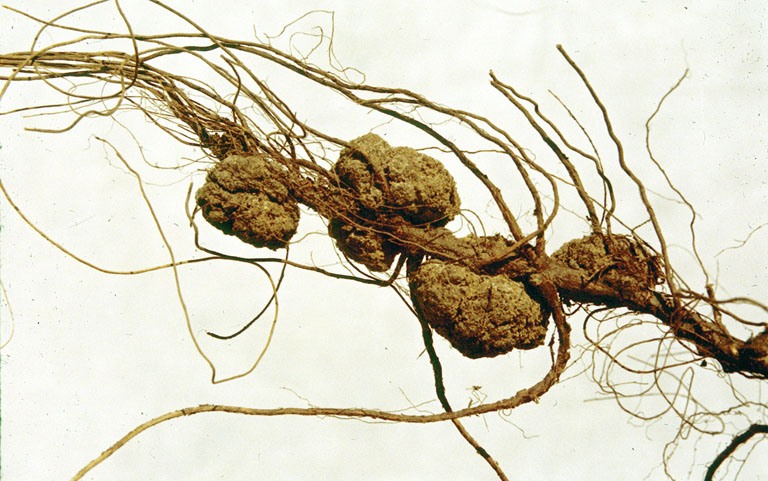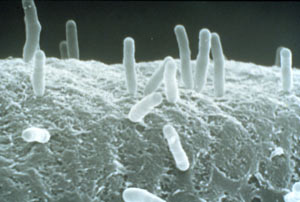Rhizobiaceae
As rhizobia or rhizobia ( ancient Greek ῥίζα rhiza = root and bios = life βίος ) are referred to certain bacteria from the family Rhizobiaceae. They belong to the class of Alphaproteobacteria. Rhizobia are gram- negative, can actively move by means of a polar or subpolar flagellum or 2-6 peritrichous flagella arranged, are aerobic and chemoorganotroph based on an oxygen breathing.
Rhizobia are frequent and common soil bacteria. The particular significance is its ability to work with plants of the legume family ( Fabaceae ) enter into a mutualistic symbiosis. The community is very narrow and leads the rhizobia to comprehensive morphological and physiological changes in plants to form specific organs. Rhizobia have the ability to elementary, molecular nitrogen (N2 ) to bind, by reducing it to ammonia (NH3 ) and ammonium (NH4 ) and thus make bioavailable. However, this is possible for them only in symbiosis with plants. Under natural conditions, neither legumes nor rhizobia can fix molecular nitrogen alone. The symbiosis is both biological as well as economic importance.
The relationship between root vigor and swelling attack by bacteria was first described in 1866 by the Russian botanist Mikhail Stepanovich Voronin on the example of lupine, which also coined the concept of root nodule bacteria. Hermann and Hermann Hellriegel Wilfarth discovered in 1886 the symbiosis of legumes and bacteria and their ability to perform elemental nitrogen from the air into plant available nitrogen compounds.
Establishment of the symbiosis
Plant roots give off various organic compounds. These exudates are used, among other things the development of a specific microorganisms Society of bacteria and fungi in the rhizosphere, ie the immediate vicinity of the root. The actively moving rhizobia are attracted chemotactically by root exudates. They are subject to certain conditions to be able to penetrate into the root ( " infection "). Prerequisite for a successful infection is always a compatible and highly specific recognition between bacteria and plant cells at the molecular level. The infection begins always at certain root cells, the so-called root hairs.
Recognition, attachment and infection
The first step, detecting and attachment to the root hair cell carried by special proteins on the surface of the bacteria and plant cell. One of the proteins produced by rhizobia is Rhicadhesin which binds to calcium compounds to the plant cell. Also plant lectins play a role, such as the Trifolin formed by white clover, which binds to specific carbohydrates of the outer cell membrane of certain Rhizobium strains.
After the attachment of the start rhizobia invade the root hair cells. The penetration is always at the top of the root hair, which then einkrümmt located in a characteristic manner and surrounds the bacterial cell.
Differentiation of the bacteria and the infected plant tissue
Phenolic root exudates (eg, luteolin ) activate a series of bacterial genes that are designated according to their function as a nod genes. Nod stands for nodulation, which means nodules or nodule formation. Some of the formed Nod proteins are released to the outside, acting on the plant cells and are necessary for the successful interaction between plant and bacterial cells.
The bacteria cause the root hair cell to form cellulose and induce an infection in the direction of root canal center. Along this channel adjacent cells of the root cortex are subsequently infected. The increased secretion of bacterial nod factors causes the neighboring cells to divide and to increase, in this case the resulting root cells are also often polyploid. This leads to the formation of nodule- like root thickening, the " root nodules " in which there are the rhizobia.
First, multiply the slender, rod-shaped bacteria. Subsequently, most begin to turn into thickened, misshapen and branched cells called Bacteroide or Bacterioide. These are enveloped in the infected plant cell and form membranes in cell organelles, which are called Symbiosomen. There is evidence that each root nodules of infection by a single bacterium is apparent. The Bacteroide a nodule were clones in this case. The Bacteroides lacks the typical proteobacteria outer cell membrane. They are also no longer able to multiply or revert to its original, replicable cells. With advancing age, the degree of branching of the Bacteroide increases.
Fixation of elemental, molecular nitrogen (N2 )
The enzymes for the N2 fixation have only the rhizobia, not the plants. However, the most important enzyme, the molybdenum-containing nitrogenase is sensitive to oxygen in a high degree. Even low concentrations of oxygen irreversibly inactivate the enzyme. However Bacteroide are not themselves able to live without any oxygen. For the successful nitrogen fixation, the oxygen concentration in the root nodules must therefore be exactly balanced. This function takes the plant cell by forming an iron-containing protein in the nodules. This leghaemoglobin binds excess oxygen, keeps its level constant and thus fulfills an oxygen buffer function. The leghaemoglobin is similar in structure to the equally strong oxygen-binding hemoglobin blood (but it binds only one molecule of oxygen and not four) and stain the fabric of active root nodules pale pink to blood red.
The cleavage of the nitrogen triple bond for subsequent fixation requires a lot of energy. To split a molecule of nitrogen, 16 ATP and NADH 4 are required. 16 in order to generate ATP, at least four molecules of oxygen to be reduced in the respiratory chain. That is, an optimal fixation would need a gas mixture consisting of four parts of oxygen and one part of nitrogen. As is known, the ratio of these two gases in the atmosphere, however, is reversed. Oxygen in the cells that is " scarce ". In fact, the leghaemoglobin increases the flow of oxygen to the bacteroids due to the much higher solubility of leghaemoglobin -oxygen complex over the simple oxygen molecule, despite the reduced diffusion rate due to the enormous increase in volume and mass.
The oxygen- sensitive nitrogen-fixing enzyme nitrogenase is protected from bacteroids themselves, since the respiratory chain, in which the ATP is formed in its membrane, ie the outside located. There, the oxygen is consumed and can not hurt as the nitrogenase inside the bacteroids, unless it can not be enough oxygen in the respiratory chain are consumed for any reason.
Until recently it was assumed that the components for the formation of functional hemoglobin were made cooperatively: The protein component, ie, the globin was synthesized by the plant cell, while the heme portion formed with the porphyrin ring through the Bacteroide and exported into the plant cell would. In the plant cell are put into effect with the incorporation of the ferrous ion, the assembly of the complete leghaemoglobin. Recent findings, however, show that the blueprint for leghaemoglobin is exclusively on the plant's DNA and the leghemoglobin is synthesized only there.
Mass transfer
The Bacteroide are nutritionally dependent on the plant. The plant is to meet the energy requirement for nitrogen fixation, organic carbon compounds such as succinate, malate and fumarate, ie intermediates of the citric acid cycle are available. These substances originate from the photosynthesis of the plant. Due to the degradation of the compounds the Bacteroide gain energy in the form of ATP and reducing agent, in this case, pyruvate, to hydrolysis and reduction of the nitrogen molecule. This reaction is extremely energy-intensive. To convert a single N2 molecule are required at least 16 molecules of ATP. The Bacteroide provide in return to the plant cell, mainly ammonia (NH3 ) as the first stable product of nitrogen fixation, which is implemented in an aqueous medium to form ammonium ions ( NH4 ). However, ammonia is a potent cytotoxin. To avoid an ammonia accumulation in the plant cells, it is now for the synthesis of glutamine and glutamic acid used further (ammonia assimilation ).
Genetics and compatibility groups
The bacterial genes for the establishment of symbiotic as well as for nitrogen fixation are not usually in the bacterial genome, but on a plasmid, the sym plasmid.
The genes which are necessary for nodule formation and primarily act on the plant cells are referred to as NOD genes (nod is nodulation - pilling ). The genes for nitrogen fixation are called nif genes ( nif stands for nitrogen fixation - nitrogen fixation ).
In addition, genes are present that are necessary for the highly specific recognition between bacterial and plant cell: rhizobia always belong to a specific group compatibility. A certain strain of bacteria can form a symbiosis under natural conditions may only work for a particular plant species. Bacteria that have specialized, for example, on clover (Trifolium sp.) Can establish with other legumes no successful symbiosis. One speaks in this case of " biovars ": Rhizobium leguminosarum biovar trifolii is a strain that is found only on clover. If one transfers but the corresponding compatibility genes, other plants can serve as symbionts.
Ecology
Nitrogen is essential for all organisms. It is an essential component of amino acids, and thus proteins, as well as nucleic acids, ie, DNA and RNA.
Animals obtain their nitrogen mostly through acquisition of whole amino acids by feeding on other organisms. Therefore you have sufficient nitrogen sources.
Most plants and many microorganisms, however, can only assimilate inorganic nitrogen. Bound, so in the present compounds and thus biologically available nitrogen is used as nitrate, urea or ammonium present in waters and soils. Such nitrogen compounds under natural conditions but usually scarce and limiting for the growth of these organisms. The largest nitrogen reservoir is located in elemental, molecular form (N2 ) in the air ( 78 volume percent) and dissolved in the water in this form is for animals, plants, fungi, and most microorganisms but is unusable. Only a few bacteria and archaea have the enzymes can be reduced with the aid of N2 and converted into a form that is usable for other organisms ( nitrogen fixation ). The bacterial nitrogen fixation is thus of fundamental importance for the life and the global nitrogen cycle.
The symbiosis with rhizobia N2 is indirectly available to the plants. Legumes on nitrogen-poor soils therefore have a clear selective advantage. Many Fabaceae also play an important role as pioneer plants on sand and rubble heaps and clearcuts.
Importance of symbiosis
It is estimated the amount of nitrogen fixed annually to over 120 million tonnes. Plants that grow in this way to less valuable soils have large share of agriculture and our food source. Leguminous plants and their fruits are often rich in protein, which is certainly due to the good supply of nitrogen. In addition, legumes are grown as green manure for natural enrichment of the soil with nitrogen.
Examples of plant genera, which can form a symbiosis with rhizobia:
And others, including many tropical genera common.
The most common plant species that live in symbiosis with rhizobia, belong to the pea family ( Faboideae ), but also within these closely related locust bean plants ( Caesalpinioideae ) and mimosa family ( Mimosoideae ) one finds symbioses with rhizobia. Important Rhizobium species Rhizobium leguminosarum, R. tropici, R. loti, R. trifolii, R. meliloti, R. fredii, Bradyrhizobium japonicum, B. elkanii, Azorhizobium caulinodans ( tropical, forms stem nodules ).
The symbiosis between plants and nitrogen-fixing bacteria is not restricted to legumes and rhizobia. Tight communities can be found, for example, between alder and actinomycetes of the genus Frankia or water fern Azolla and the tropical cyanobacteria of the genus Anabaena.
Accumulations of nitrogen-fixing bacteria were also detected in the rhizosphere of different grasses. Carbohydrates, which secrete the plant roots, are used here as an energy source.
There are also free-living bacteria that - without taking a symbiosis - N2 only for their own consumption assimilate (eg, Azotobacter and some cyanobacteria ). This type of nitrogen assimilation, the " nitrogen fixation " is, however, strictly regulated due to the high demand for energy and occurs only when no other nitrogen source is available.









